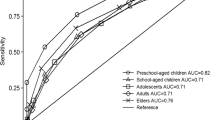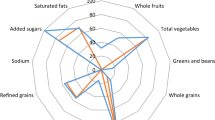Abstract
Objective: To examine the association between nutrient adequacy and dietary diversity, and to assess and compare the determinants for the two constructs in an adult population in rural Mali.
Design: Cross-sectional study assessing food intake by a validated 7-day quantitative food frequency questionnaire. Two different dietary diversity indexes were created: food variety score (FVS), a simple count of food items, and diet diversity score (DDS) a count of food groups. Mean adequacy ratio, the mean ratio of intake to recommended intake (each truncated at one) of energy and nine nutrients, was calculated as an indicator of nutrient adequacy. Information on household and individual characteristics, including demography, socioeconomic conditions and food production strategies was obtained using precoded questionnaires.
Setting: Bafoulabé district, Kayes region, Western Mali.
Subjects: In total, 502 subjects (55% women) aged 15–45 y from 319 different households.
Results: Both FVS and DDS had a positive correlation with mean adequacy ratio (MAR). Multivariate analysis (linear regression) showed that the most important factors explaining MAR was the number of milk products, vegetables and green leaves consumed, as well as sex and the number of crops produced in the household. Dietary diversity was associated with socioeconomic status, residence and age.
Conclusions: Dietary diversity is useful as an indicator of nutrient adequacy. It is important to examine how various food groups contribute to the nutrient adequacy of the diet in an area.
Sponsorship: The Norwegian Research Council and The Strømme Foundation funded the project.
This is a preview of subscription content, access via your institution
Access options
Subscribe to this journal
Receive 12 print issues and online access
$259.00 per year
only $21.58 per issue
Buy this article
- Purchase on Springer Link
- Instant access to full article PDF
Prices may be subject to local taxes which are calculated during checkout
Similar content being viewed by others
References
Altman DG (1997): Practical Statistics for Medical Research. London: Chapman & Hall.
Black AE (2000): The sensitivity and specificity of the Goldberg cut-off for EI:BMR for identifying diet reports of poor validity. Eur. J. Clin. Nutr. 54, 395–404.
FAO, WHO & UNU (1985): Energy and protein requirements. Report of a joint FAO/WHO/UNU Expert Consultation. Technical Report Series no. 724. Geneva: World Health Organization.
FAO & WHO (1994): Fats and oils in human nutrition. Report of a joint FAO/WHO Expert Consultation. FAO technical papers. Rome: Food and Agriculture Organization of the United Nations.
FAO & WHO (2001): Human vitamin and mineral requirements. Report of a joint FAO/WHO Expert Consultation. FAO technical papers. Rome: Food and Agriculture Organization of the United Nations.
Gittelsohn J, Mookherji S & Pelto GH (1998): Operationalizing household food security in rural Nepal. Food Nutr. Bull. 19, 210–222.
Goldberg GR, Black AE, Jebb SA, Cole TJ, Murgatroyd PR, Coward WA & Prentice AM (1991): Critical evaluation of energy intake data using fundamental principles of energy physiology: 1. Derivation of cut-off limits to identify under-recording. Eur. J. Clin. Nutr. 45, 569–581.
Haddad L, Kennedy E & Sullivan J (1994): Choice of indicators for food security and nutrition monitoring. Food Policy 19, 329–343.
Haines PS, Siega-Riz AM & Popkin BM (1999): The diet quality index revised: a measurement instrument for populations. J. Am Diet. Assoc. 99, 697–704.
Hatløy A, Hallund J, Diarra MM & Oshaug A (2000): Food variety, socio-economic status and nutritional status in urban and rural areas in Koutiala (Mali). Public Health Nutr. 3, 57–65.
Hatløy A, Torheim LE & Oshaug A (1998): Food variety—a good indicator of nutritional adequacy of the diet? A case study from an urban area in Mali, West Africa. Eur. J. Clin. Nutr. 52, 891–898.
Hoddinott J & Yohannes Y (2002): Dietary diversity as a food security indicator. FCND Discussion paper 136. Washington, DC: International Food Policy Research Institute.
Kant AK, Schatzkin A, Ziegler RG & Nestle M (1991): Dietary diversity in the US population, NHANES II, 1976–1980. J. Am. Diet. Assoc. 91, 1526–1531.
Kennedy ET, Ohls F, Carlson S & Fleming K (1995): The healthy eating index: design and applications. J. Am Diet. Assoc. 95, 1103–1108.
Krebs-Smith SM, Smiciklas-Wright H, Guthrie HA & Krebs-Smith J (1987): The effects of variety in food choices on dietary quality. J. Am. Diet. Assoc. 87, 897–903.
National Household Survey Capability Programme (1986): Annex 1:Summary procedures. How to weigh and measure children: assessing the nutritional status of young children in household surveys. New York: United Nations, Department of Technical Co-operation for Development and Statistical Office.
Ogle BM, Hung PH & Tuyet HT (2001): Significance of wild vegetables in micronutrient intakes of women in Vietnam: an analysis of food variety. Asia Pacific J. Clin. Nutr. 10, 21–30.
Oshaug A, Diarra M, Torheim LE, Diallo F, Diakité M, Sissoko F, Hatløy A & Ouattara F (1997): Etude qualitative des besoins de la population à Bafoulabé. Programme de collaboration PIDEB/INRSP/Université d’Oslo. Oslo: Institute of Nutrition Research, University of Oslo.
Parr CL, Barikmo I, Torheim LE, Ouattara F, Kaloga A & Oshaug A (2002): Validation of the second version of a quantitative food-frequency questionnaire for use in Western Mali. Public Health Nutr. 5, 769–781.
Ruel MT (2002): Is dietary diversity an indicator of food security or dietary quality? A review of measurement issues and research needs. FCND Discussion Paper 140. Washington DC: International Food Policy Research Institute.
SPSS (2001): SPSS 11.0 for Windows. Chicago: SPSS Inc.
Stookey JD, Wang K, Ge K, Lin H & Popkin BM (2000): Measuring diet quality in China: the INFH-UNC-CH Diet Quality Index. Eur. J. Clin. Nutr. 54, 811–821.
Torheim LE, Barikmo I, Hatløy A, Diakité M, Solvoll K, Diarra MM & Oshaug A (2001): Validation of a quantitative food-frequency questionnaire for use in Western Mali. Public Health Nutr. 4, 1267–1277.
Torheim LE, Barikmo I, Parr CL, Hatloy A, Ouattara F & Oshaug A (2003): Validation of food variety as an indicator of diet quality assessed with a food frequency questionnaire for Western Mali. Eur. J. Clin. Nutr. 57, 1283–1291.
Toulmin C (1986): Access to food, dry season strategies and household size amongst the Bambara of Central Mali. IDS Bull 17, 58–67.
Acknowledgements
We thank the staff of Action d’Appui aux Initiatives de Développement de Bafoulabé (AIDEB) in Bafoulabé and the Strømme Foundation in Bamako for their support and cooperation. We acknowledge greatly the fieldworkers for their painstaking efforts in collecting the data. Our thanks also go to Christine Parr for her helpful input to the manuscript.
Author information
Authors and Affiliations
Contributions
Guarantor: LE Torheim.
Contributors: LET planned and executed the study, analyzed the data and prepared the initial draft of the manuscript. FO, MMD and FDT participated in the planning and execution of the study and the initial data analyses. IB conducted the analysis of food and nutrient intake. AH and AO collaborated in planning the study and in obtaining funding. All co-authors participated in the reviewing of the manuscript.
Corresponding author
Appendix 1
Appendix 1
See Table A1.
Rights and permissions
About this article
Cite this article
Torheim, L., Ouattara, F., Diarra, M. et al. Nutrient adequacy and dietary diversity in rural Mali: association and determinants. Eur J Clin Nutr 58, 594–604 (2004). https://doi.org/10.1038/sj.ejcn.1601853
Received:
Revised:
Accepted:
Published:
Issue Date:
DOI: https://doi.org/10.1038/sj.ejcn.1601853
Keywords
This article is cited by
-
Diet diversity and food quality score in male football players and healthy non-athlete controls in relation to oxidative stress biomarkers: a descriptive-analytical study
BMC Sports Science, Medicine and Rehabilitation (2023)
-
Forest regrowth improves people’s dietary quality in Nigeria
npj Sustainable Agriculture (2023)
-
Articulating fertilizer subsidy effects on women’s diet quality by food supply source in Mali
CABI Agriculture and Bioscience (2022)
-
Linkages between dietary diversity and indicators of agricultural biodiversity in Burkina Faso
Food Security (2021)
-
Livelihood, culture and patterns of food consumption in rural Burkina Faso
Food Security (2021)



